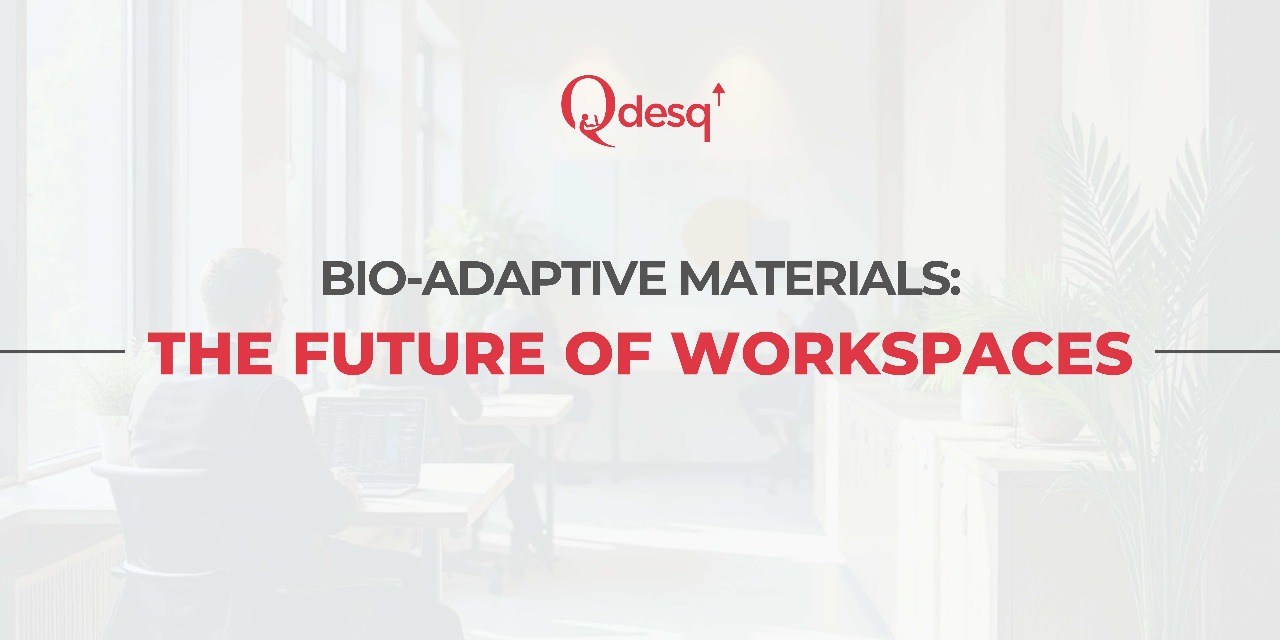Modern workplaces are entering a new era powered by bio-adaptive materials—innovations that unite human wellbeing, nature, and intelligent design. These next-generation materials dynamically respond to light, air quality, humidity, and movement, allowing offices to “breathe” and adjust naturally.
As flexible and hybrid work models expand, Indian coworking spaces and office developers are increasingly adopting such living design systems to create healthier, more sustainable environments. But how exactly do these materials transform workplaces and solve real challenges like fatigue, poor focus, and declining employee engagement?
What Are Bio-Adaptive Materials and Why They Matter
Bio-adaptive materials are intelligent, environmentally responsive elements inspired by biological processes. They adjust their behaviour to environmental changes without significant external energy. Examples include air-purifying wall finishes, temperature-regulating fabrics, and solar-sensitive façade systems that adapt to sunlight.
This design philosophy is built on the principles of biophilia, which fosters harmony between humans and nature through architecture. Unlike static workplaces filled with artificial lighting and recycled air, bio-adaptive interiors evolve continuously—enhancing comfort, clarity, and vitality for occupants.
In Indian cities, which face pollution and climatic variability, such materials are increasingly essential. They support cleaner air, lower energy use, and a more comfortable work experience—three qualities that modern professionals actively seek in their everyday workspaces.
Solving Real Workplace Challenges Through Adaptivity
The modern employee seeks a sense of physical and psychological balance. Bio-adaptive design effectively addresses some of the most persistent office challenges:
- Fatigue and Focus: Materials that fine-tune illumination and temperature levels help maintain concentration, reducing glare and stress over long work hours.
- Air Quality and Health: Air-purifying surfaces and antimicrobial coatings diminish pollutants, providing a healthier microclimate inside shared offices.
- Climate and Energy Balance: Smart thermal surfaces automatically optimise heating and cooling, cutting operational energy without compromising comfort.
- Noise and Distraction: Living walls and soft biomaterials act as natural sound absorbers, encouraging calmness and privacy in collaborative settings.
By integrating these solutions, workplaces evolve into adaptive ecosystems—office spaces that cater to people’s biological needs rather than expecting people to adjust to their environment.
India’s Emerging Trend Toward Bio-Adaptive Workspaces
Across metro markets such as Bengaluru, Mumbai, Chennai, Hyderabad, and the Delhi NCR region, workspace providers are exploring biophilic or bio-adaptive upgrades as a distinctive value addition. These innovations align with a wider shift toward sustainable, experience-driven work models.
Notable examples include:
- Vertical gardens and moss panels that stabilise humidity and absorb pollutants.
- Smart HVAC systems that increase oxygen flow when occupancy rises.
- Adaptive daylight panels synchronised with natural circadian rhythms.
- Bio-composite furniture crafted from renewable fibres like bamboo or mycelium.
These tangible integrations not only elevate aesthetics but also contribute to employee happiness, retention, and brand perception—critical outcomes in India’s growing flex workspace economy.
The Science Behind Wellbeing and Performance
Research consistently shows that workers perform best when their environment mirrors natural rhythms. Constant artificial conditions—harsh light, poor ventilation, static temperature—cause strain that reduces cognitive clarity by nearly one-fourth. Conversely, biologically attuned environments improve mental alertness, mood stability, and creative engagement.
Adaptive design thus becomes a strategic tool for productivity. A healthier, nature-connected office can lower absenteeism while nurturing collaboration and team morale. Beyond aesthetics, bio-adaptive materials represent a scientific rethinking of office ergonomics and neuroarchitecture, creating workspaces that simultaneously boost focus and interpersonal well-being.
Technology and Sustainability Converge
At the intersection of biomimicry and smart technology, bio-adaptive design introduces measurable sustainability. Embedded sensors and intelligent control systems enable real-time responses to external conditions—balancing sunlight, ventilation, and even acoustics.
Picture a conference room where artificial light automatically softens as daylight brightens, or a desk that adjusts its surface temperature based on user presence. Such seamless adaptability integrates environmental awareness with tech-driven precision.
In India’s evolving commercial real estate landscape, where energy efficiency and cost optimisation are vital, bio-adaptive materials redefine how buildings perform. They reduce resource consumption while maintaining a premium, wellness-oriented experience that attracts diverse tenants and enhances operational ROI.
The Future of Workspaces
The future office is alive, intelligent, and regenerative. Bio-adaptive materials signal a shift from rigid architecture to responsive environments that sense, learn, and support human vitality. As businesses and professionals demand mindful workspaces that align with wellness and sustainability, adaptive design will guide the next era of workspace creation.
Conclusion
Bio-adaptive office design isn’t just an architectural innovation—it’s a wellness revolution. By integrating nature with technology, workplaces evolve into living systems that support human energy, focus, and creativity every day.
Whether you’re an independent professional seeking inspiration or a company building eco-efficient teams, Qdesq connects you to modern flexible workspace solutions that integrate thoughtful, sustainable design.
Discover your next workspace that grows with you—where design, wellbeing, and technology thrive in perfect balance.











